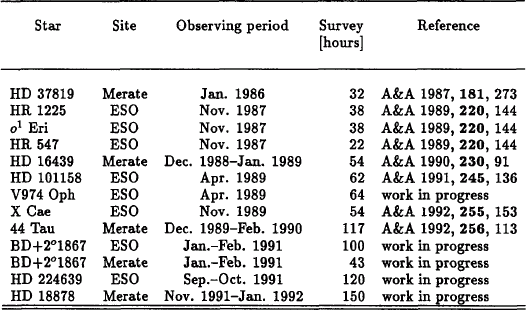No CrossRef data available.
Article contents
Methodological Aspects in the Frequency Analysis of Multiperiodic δ Scuti Stars
Published online by Cambridge University Press: 12 April 2016
Extract
At Merate Observatory the study of δ Sct stars began in the sixties and spectroscopie and photometric campaigns were continuously undertaken in order to clarify the controversial points. As an obvious extension of the research, the observation of δ Sct stars was proposed for telescope-time allocation at European Southern Observatory, in order to take advantage of the ESO facilities and of the considerably better sky of La Silla. We put in our observing programme δ Sct stars showing cycle-to-cycle variations and, possibly, an amplitude larger than 0.05 mag in order to have a better signal-to-noise ratio; they are listed in the table. It is important to notice that we always tried to collect a number of measurements as large as possible (from 1988 we collected more than 1000 measurements per star), because it is a well-established fact that periodicities with

an amplitude of a few thousandths of magnitude can be present in δ Sct stars. Moreover, when several modes are excited, an adequate frequency resolution becomes necessary and, therefore, a sufficient time baseline is requested (Poretti and Mantegazza 1992). A poor data sampling also gives an apparent good fitting for several solutions, all leaving a small residual rms, and there is no possibility to choose among them: different authors can pick up different solutions, generating the conflicting interpretations often found in δ Sct star literature.
- Type
- VIII. Asteroseismology: observation
- Information
- Copyright
- Copyright © Astronomical Society of the Pacific 1993


